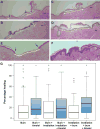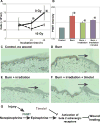The Beta 2 Adrenergic Receptor Antagonist Timolol Improves Healing of Combined Burn and Radiation Wounds
- PMID: 29373090
- PMCID: PMC5890811
- DOI: 10.1667/RR14884.1
The Beta 2 Adrenergic Receptor Antagonist Timolol Improves Healing of Combined Burn and Radiation Wounds
Abstract
In a scenario involving a nuclear detonation during war or a terrorist attack, acute radiation exposure combined with thermal and blast effects results in severe skin injury. Although the cutaneous injury in such a scenario may not be lethal, it may lead to inflammation, delayed wound healing and loss of the skin barrier, resulting in an increased risk of infection. In this study, we tested the potential use of timolol, a beta-adrenergic receptor antagonist, to improve epidermal wound closure after combined burn and radiation injury using an ex vivo human skin culture model. Daily application of 10 μ M timolol after combined injury (burn and 10 Gy ex vivo irradiation) increased wound epithelialization by 5-20%. In addition, exposure to 10 Gy significantly suppressed epidermal keratinocyte proliferation by 46% at 48 h postirradiation. Similar to what has been observed in a thermal burn injury, the enzyme phenylethanolamine N-methyltransferase (PNMT), which generates epinephrine, was elevated in the combined thermal burn and radiation wounds. This likely resulted in elevated tissue levels of this catecholamine, which has been shown to delay healing. Thus, with the addition of timolol to the wound to block the binding of locally generated epinephrine to the beta-adrenergic receptor, healing is improved. This work suggests that by antagonizing local epinephrine action within the wound, a beta-adrenergic receptor antagonist such as timolol may be a useful adjunctive treatment to improve healing in the combined burn and radiation injury.
Figures


Similar articles
-
Stress-mediated increases in systemic and local epinephrine impair skin wound healing: potential new indication for beta blockers.PLoS Med. 2009 Jan 13;6(1):e12. doi: 10.1371/journal.pmed.1000012. PLoS Med. 2009. PMID: 19143471 Free PMC article.
-
Development of a combined radiation and full thickness burn injury minipig model to study the effects of uncultured adipose-derived regenerative cell therapy in wound healing.Int J Radiat Biol. 2017 Mar;93(3):340-350. doi: 10.1080/09553002.2017.1242814. Epub 2016 Oct 21. Int J Radiat Biol. 2017. PMID: 27690716
-
Beta2-adrenergic receptor activation delays wound healing.FASEB J. 2006 Jan;20(1):76-86. doi: 10.1096/fj.05-4188com. FASEB J. 2006. PMID: 16394270
-
Sugar-coating wound repair: a review of FGF-10 and dermatan sulfate in wound healing and their potential application in burn wounds.J Burn Care Res. 2012 May-Jun;33(3):299-310. doi: 10.1097/BCR.0b013e318240540a. J Burn Care Res. 2012. PMID: 22561305 Free PMC article. Review.
-
The role of topical timolol in wound healing and the treatment of vascular lesions: A narrative review.Dermatol Ther. 2021 Mar;34(2):e14847. doi: 10.1111/dth.14847. Epub 2021 Feb 13. Dermatol Ther. 2021. PMID: 33538017 Review.
Cited by
-
An Overview of Radiation Countermeasure Development in Radiation Research from 1954 to 2024.Radiat Res. 2024 Aug 1;202(2):420-431. doi: 10.1667/RADE-24-00036.1. Radiat Res. 2024. PMID: 38964743 Free PMC article. Review.
-
[Mechanisms of adrenergic β-antagonist for wounds and its application prospect in diabetic foot ulcers].Zhongguo Xiu Fu Chong Jian Wai Ke Za Zhi. 2020 Dec 15;34(12):1630-1634. doi: 10.7507/1002-1892.202002063. Zhongguo Xiu Fu Chong Jian Wai Ke Za Zhi. 2020. PMID: 33319548 Free PMC article. Review. Chinese.
-
Sympathetic System in Wound Healing: Multistage Control in Normal and Diabetic Skin.Int J Mol Sci. 2023 Jan 20;24(3):2045. doi: 10.3390/ijms24032045. Int J Mol Sci. 2023. PMID: 36768369 Free PMC article. Review.
-
Sex-dependent effects of genetic upregulation of activated protein C on delayed effects of acute radiation exposure in the mouse heart, small intestine, and skin.PLoS One. 2021 May 24;16(5):e0252142. doi: 10.1371/journal.pone.0252142. eCollection 2021. PLoS One. 2021. PMID: 34029348 Free PMC article.
-
Acute chemoradiotherapy toxicity in cervical cancer patients.Open Med (Wars). 2020 Sep 2;15(1):822-832. doi: 10.1515/med-2020-0222. eCollection 2020. Open Med (Wars). 2020. PMID: 33336040 Free PMC article.
References
-
- Pellmar TC, Ledney GD. NATO RTG-099 2005. Bethesda, MD: Armed Forces Radiobiology Research Institute; 2005. Combined injury: Radiation in combination with trauma, infectious disease, or chemical exposure; pp. 1–9.
-
- Planning guidance for response to a nuclear detonation. Washington, DC: Environmental Protection Agency; 2017. ( https://fas.org/irp/threat/detonation.pdf)
-
- Meineke V. The role of damage to the cutaneous system in radiation-induced multi-organ failure. BJR Suppl. 2005;27:85–99.
Publication types
MeSH terms
Substances
Grants and funding
LinkOut - more resources
Full Text Sources
Other Literature Sources
Medical
Research Materials
Miscellaneous

